- Art
- Exhibitions
- What, Me Worry? The Art and Humor of MAD Magazine
- Recall. Reframe. Respond. The Art of Paul Scott
- Rediscovered Treasures
- Special Features
- Upcoming Exhibitions
- Past Exhibitions
- Online Exhibitions
- Explore the Collection
- Provenance and Cultural Property
- Conservation
- Meet the Curators
- Digital Resources
- Art Bridges Cohort Program
Introduction
I’m Charlotte Ogorek, the museum’s Rexroth Project Assistant. I am reading the introduction for Tamary Kudita: African Victorian and Birds of Paradise.
Tamary Kudita (Zimbabwean, b. 1994) makes photographs that examine African identity in relation to the social and historical forces that frame individuals’ lives. Kudita lives and works in Zimbabwe, a country formerly colonized by Great Britain. She traces her family heritage to the Shona-speaking people of Zimbabwe and to a nineteenth-century union between a Black South African plantation worker and a Dutch soldier.
As a student, Kudita found that few images in art history reflected her complex identity or the identities of people around her. She began using the camera to blend elements of African history and everyday life with references to historical European fashion and art. Mixing cultural signifiers across centuries and continents, her portraits make the hybrid nature of African identities visible while giving everyday Zimbabweans their due.
This gallery features selections from two related bodies of work. In the series titled African Victorian, Kudita explores the personal histories of the models, who are her female friends and acquaintances, to better understand her own sense of self. In the series Birds of Paradise, she represents the models’ stories to empower them as individuals and to describe the layers of history, culture, and feeling that make up contemporary Zimbabwe.
Sight Unseen I
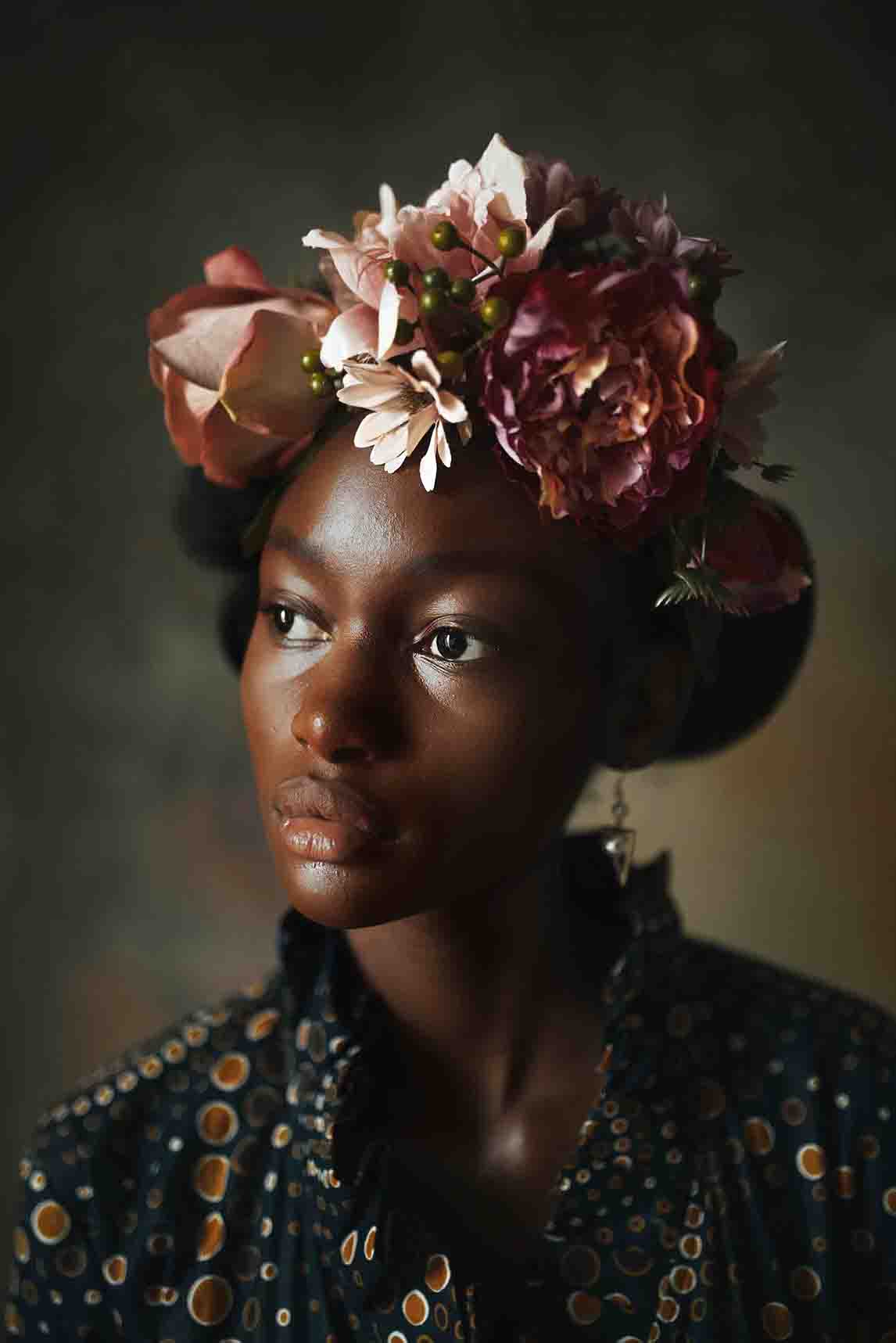
Tamary Kudita (Zimbabwean, b. 1994), Sight Unseen I, from the series African Victorian, 2019, inkjet print, Private Collection of Lesley Goldwasser and Jonathan Plutzik, with thanks to VISU Contemporary art gallery, © Tamary Kudita
Description
I’m Charlotte Ogorek, the museum’s Rexroth Project Assistant. I am reading the description for Sight Unseen I in Tamary Kudita: African Victorian and Birds of Paradise.
Sight Unseen I is a vertically oriented photograph measuring 48.3 inches tall and 33.1 inches wide, created as a part of the African Victorian series in 2019. The image and series were created by Tamary Kudita, an artist born in 1994 in Zimbabwe.
The image is a portrait of a young Black African woman in front of a dark backdrop and lit softly from an unseen source to the left of the frame. The woman is seen in close range from the shoulders up, with her body facing the camera while her face, in sharp focus, turns slightly to the left of the image. Her dark brown eyes gaze in the same direction, towards the light and something outside of the frame. Her expression is relaxed, perhaps vacant, and she wears a crown of daisies, roses, and carnations all in various shades of pink and purple atop her head. Her dark hair is pulled back, and she wears a deep blue collared dress with rows of gold dots, outlined in white.
Label
I’m Charlotte Ogorek, the museum’s Rexroth Project Assistant. I am reading the label for Sight Unseen I in Tamary Kudita: African Victorian and Birds of Paradise
Sight Unseen I is a vertically oriented photograph measuring 48.3 inches tall and 33.1 inches wide, created as a part of the African Victorian series in 2019. The image and series were created by Tamary Kudita, an artist born in 1994 in Zimbabwe.
This photograph's subject matter and light reference Saskia as Flora, a painting by the Dutch Golden Age artist Rembrandt van Rijn (1606–1669). Dutch prosperity in the seventeenth century flowed in part from colonial endeavors in southern Africa. By inserting a Black African woman in this composition, Kudita points out omissions in the canon of European art. At the same time, she suggests that representing this sitter’s identity requires thinking about how the past and present are linked.
Vessel
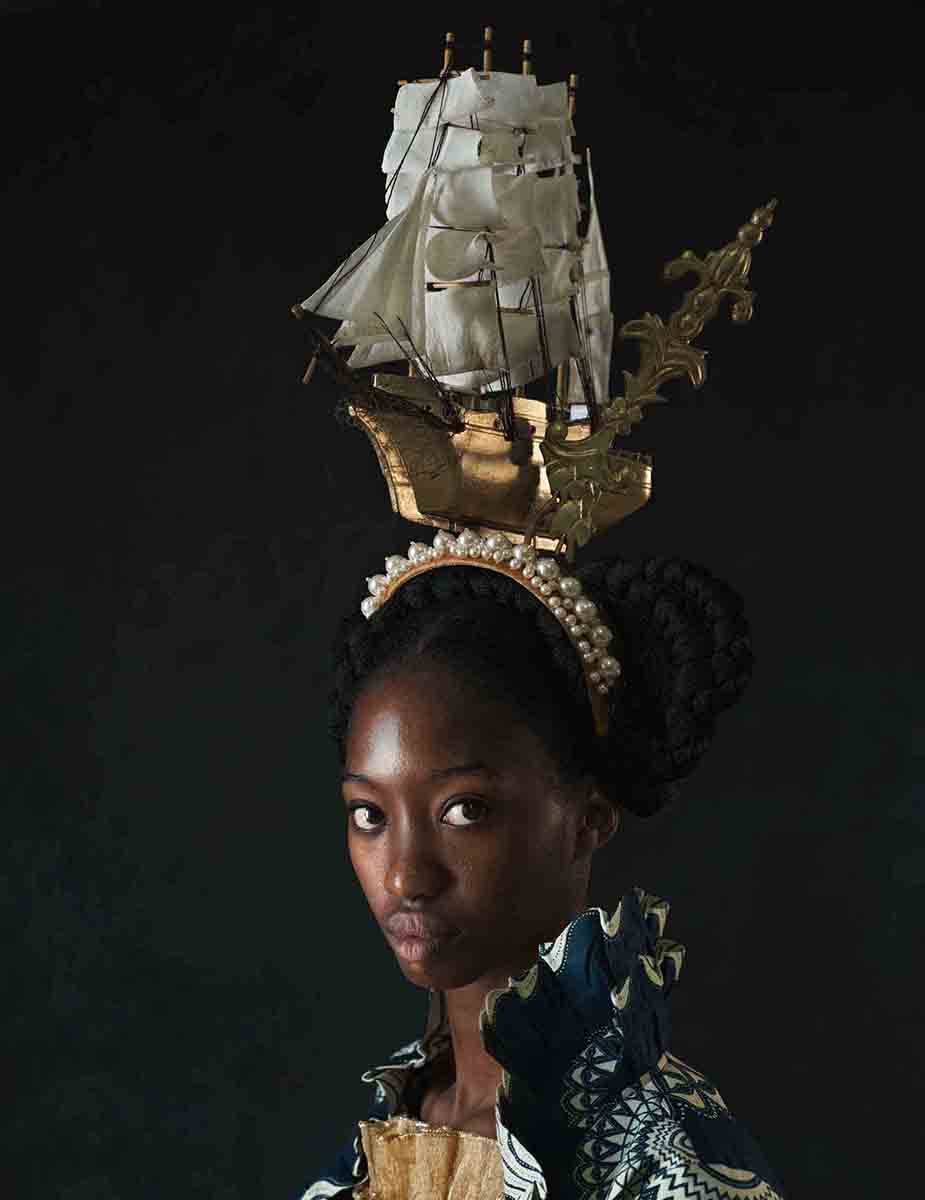
Tamary Kudita (Zimbabwean, b. 1994), Vessel, from the series African Victorian, 2020, inkjet print, Private Collection of Lesley Goldwasser and Jonathan Plutzik, with thanks to VISU Contemporary art gallery. © Tamary Kudita
Description
I’m Charlotte Ogorek, the museum’s Rexroth Project Assistant. I am reading the description for Vessel in Tamary Kudita: African Victorian and Birds of Paradise.
Vessel, a vertically oriented photograph, measures 48.3 inches tall and 37.8 inches wide. The work was created as a part of the series African Victorian, created in 2020 by the artist Tamary Kudita who was born in Zimbabwe in 1994.
Set as a studio portrait with a dark, empty background, a young Black African woman is seen from the shoulders up, with her body positioned to face the left of the image and her head turned towards the audience, staring at them directly out of the corner of her dark brown eyes. The photograph is lit by an unseen source on the left of the frame, illuminating the side of her face and eyes. She inhabits the bottom half of the frame, wearing a blue and white patterned open jacket with a high, ruffled collar over a garment with a beige, fanned lace neckline. Her dark hair is in an elaborate updo of thick braids, on top of which rests an elaborate headpiece. The headpiece occupies the upper half of the image and consists of a detailed golden ship with white sails attached to a golden headband adorned with large and small pearls. The ship is about the same size as the sitter’s head, and a secondary long, thin object, also gold and consisting of floral motifs, juts off of the headband to the right of the ship.
Label
I’m Charlotte Ogorek, the museum’s Rexroth Project Assistant. I am reading the label for Vessel in Tamary Kudita: African Victorian and Birds of Paradise.
Vessel, a vertically oriented photograph, measures 48.3 inches tall and 37.8 inches wide. The work was created as a part of the series African Victorian, created in 2020 by the artist Tamary Kudita who was born in Zimbabwe in 1994.
Vessel is a meditation on histories of migration and the notion of home. Like Kudita, the Zimbabwean woman in this portrait traces her lineage to southern Africa. Symbolizing her ancestors’ journey to what is now Zimbabwe, the woman’s dramatic headpiece suggests both an enduring sense of displacement and an indelible connection to her roots. For many viewers, this image also calls to mind the massive, multigenerational dislocation perpetrated in the transatlantic slave trade. Does the photograph’s title refer to the ship, or to the woman who moves forward even while carrying the weight of history on her shoulders?
African Pot II
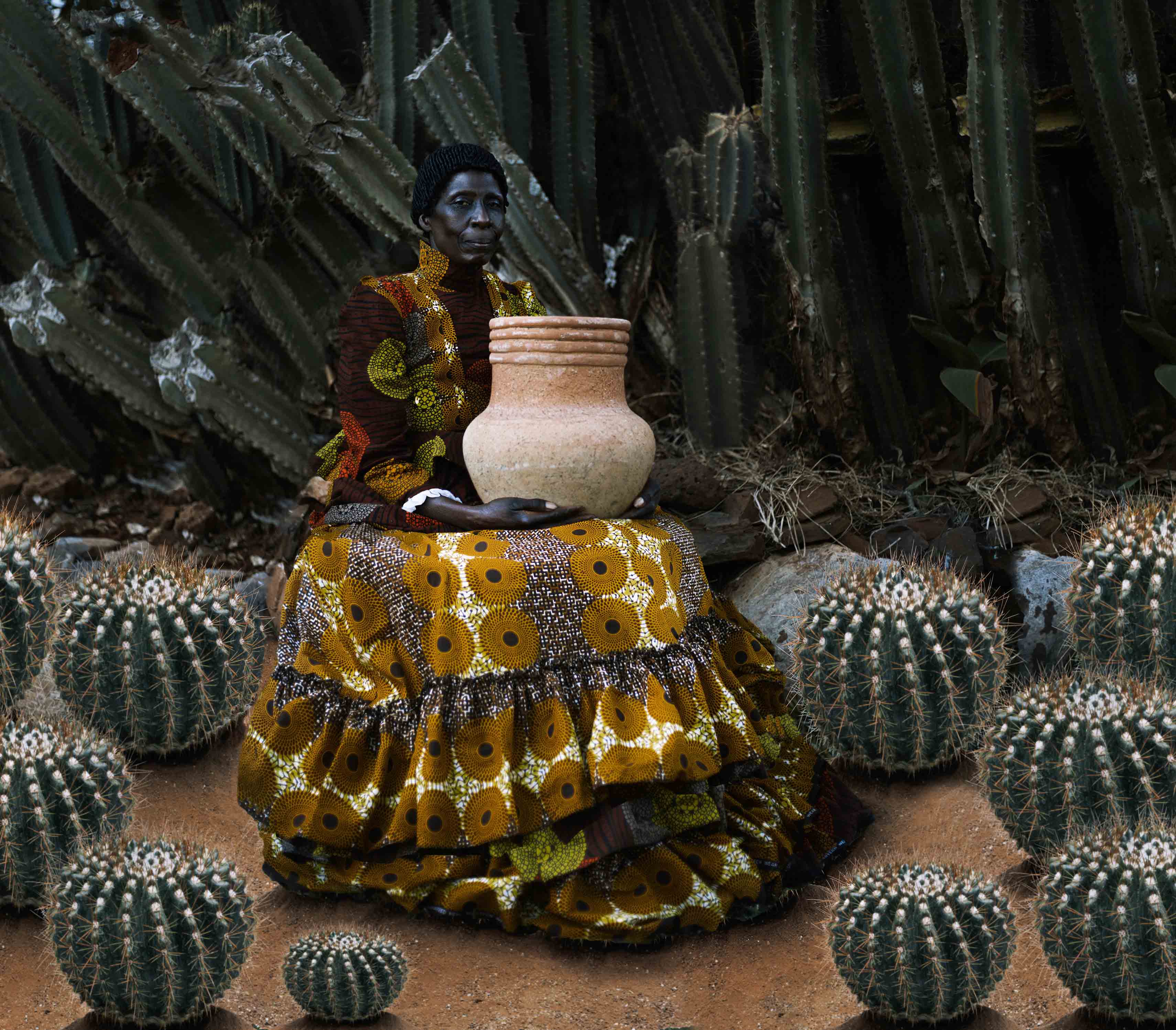
Tamary Kudita (Zimbabwean, b. 1994), African Pot II, from the series African Victorian, 2021, inkjet print, Private Collection of Lesley Goldwasser and Jonathan Plutzik, with thanks to VISU Contemporary art gallery, © Tamary Kudita
Description
I’m Charlotte Ogorek, the museum’s Rexroth Project Assistant. I am reading the description for African Pot II in Tamary Kudita: African Victorian and Birds of Paradise.
African Pot II is a large, nearly square format photograph measuring 42.5 and 48.3 inches. This inkjet print was created as a part of the African Victorian series in 2021 by Zimbabwean artist Tamary Kudita, born in 1994.
Slightly to the left of the center of the portrait, Gladys, an older Black African woman with dark skin and hair worn in a protective hairstyle tight to her scalp is seated. She is wearing a dress with a long, voluminous skirt that obscures her legs. There are multiple layers of patterned fabric featuring gold-colored circles, each with a smaller dark circle in the center, against a geometric background with black, gold, and yellow. She also wears an open jacket with a high collar in a deep red color, with mandala-like circles of green, gold, and bright red. The sleeves are three-quarters length with white scalloped trim. Her body is positioned slightly towards the right of the image, with her head turned to face the camera. Her lips are pursed, and she gazes directly at the audience. On her lap, she holds a light beige, organic clay pot, which is almost as large as her torso. The pot is wide on the bottom but tapers around halfway up into a long neck with four coiled rings at the top. The woman is outdoors, with tan sand covering the ground. Round cacti of various sizes surround the woman, and behind her in the background there are tall, thin, elongated cacti on a slightly elevated, rocky surface.
Label
I’m Charlotte Ogorek, the museum’s Rexroth Project Assistant. I am reading the label for African Pot II in Tamary Kudita: African Victorian and Birds of Paradise.
African Pot II is a large, nearly square format photograph measuring 42.5 and 48.3 inches. This inkjet print was created as a part of the African Victorian series in 2021 by Zimbabwean artist Tamary Kudita, born in 1994.
African Pot II is one of several portraits Kudita has made of a woman, Gladys, who supports her family by working at a grocery store in Harare, Zimbabwe. Although indispensable to society, Gladys and others like her are largely invisible in prevailing cultural narratives. Kudita places her at the center of a magisterial portrait, reinventing her work apron as a regal dress and placing in her hands a type of pot used to carry water—labor at the foundation of human society. The tall cacti behind Gladys and the round cacti that Kudita digitally superimposed in the foreground also store water, suggesting a long and complex interplay between natural systems and human technology.
King’s Peak
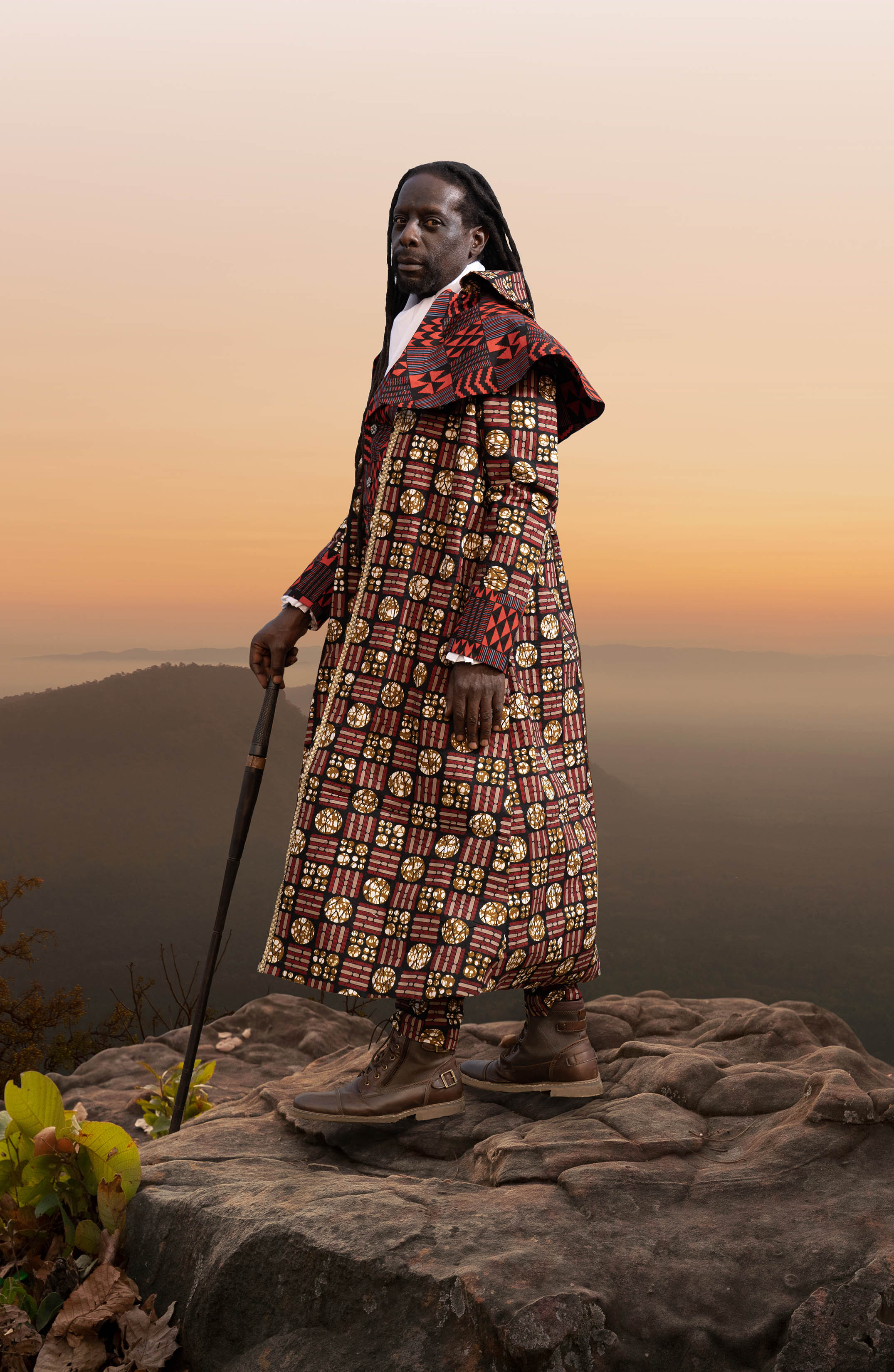
Tamary Kudita (Zimbabwean, b. 1994), King’s Peak, from the series Birds of Paradise, 2022, inkjet print, Private Collection of Lesley Goldwasser and Jonathan Plutzik, with thanks to VISU Contemporary art gallery, © Tamary Kudita
Description
I’m Charlotte Ogorek, the museum’s Rexroth Project Assistant. I am reading the description for King’s Peak in Tamary Kudita: African Victorian and Birds of Paradise.
King’s Peak is a large, vertically oriented photograph measuring 48.68 inches tall and 33.1 inches wide. The inkjet print was created in 2022 as a part of the Birds of Paradise series by the artist Tamary Kudita, born in 1994 in Zimbabwe.
This striking portrait features a Black African man with long locs centered in the frame. He stands straight, with his body positioned towards the left of the photograph, with his feet facing the same direction and his head turned to face the audience. His left leg, closest to the audience, is slightly in front of the other, and in his right hand he holds a long, dark walking stick. He wears a white collar, perhaps an ascot, beneath a long coat that nearly reaches his ankles. The coat is patterned with square motifs reminiscent of patchwork, some featuring horizontal red and white stripes, some with a singular cream circle with gold-colored marbling, and some with various sizes of circles with the same design. The cuffs of the sleeves and the capelet have larger squares of red and black triangles and red, blue, and black stripes. The cuffs of a white ruffled shirt sleeve peek out from beneath the jacket, and he wears brown leather boots with laces and buckles.
Label
I’m Charlotte Ogorek, the museum’s Rexroth Project Assistant. I am reading the label for King’s Peak in Tamary Kudita: African Victorian and Birds of Paradise.
King’s Peak is a large, vertically oriented photograph measuring 48.68 inches tall and 33.1 inches wide. The inkjet print was created in 2022 as a part of the Birds of Paradise series by the artist Tamary Kudita, born in 1994 in Zimbabwe.
Reminiscent of European Romanticism, this composition conveys a sensitive, poetic interiority and a rugged sense of dominion over the land. For Kudita, it is an homage to the historical Shona kings and queens of Great Zimbabwe, embodied in a real citizen of the contemporary, post-colonial nation.
The costumes Kudita designs for her models mix old-fashioned European clothing styles with printed fabrics that are strongly associated with Africa. While Africans use this type of fabric to express a myriad of African national and cultural identities, Dutch merchants introduced the fabric to Africa. Here, the Zimbabwean model’s cape is made from a variation on a cloth associated with the west African nation of Nigeria. His costume speaks to the movement of cloth between African cultural groups as well as the possibilities opened by creative adaptation of material culture.
Muroora
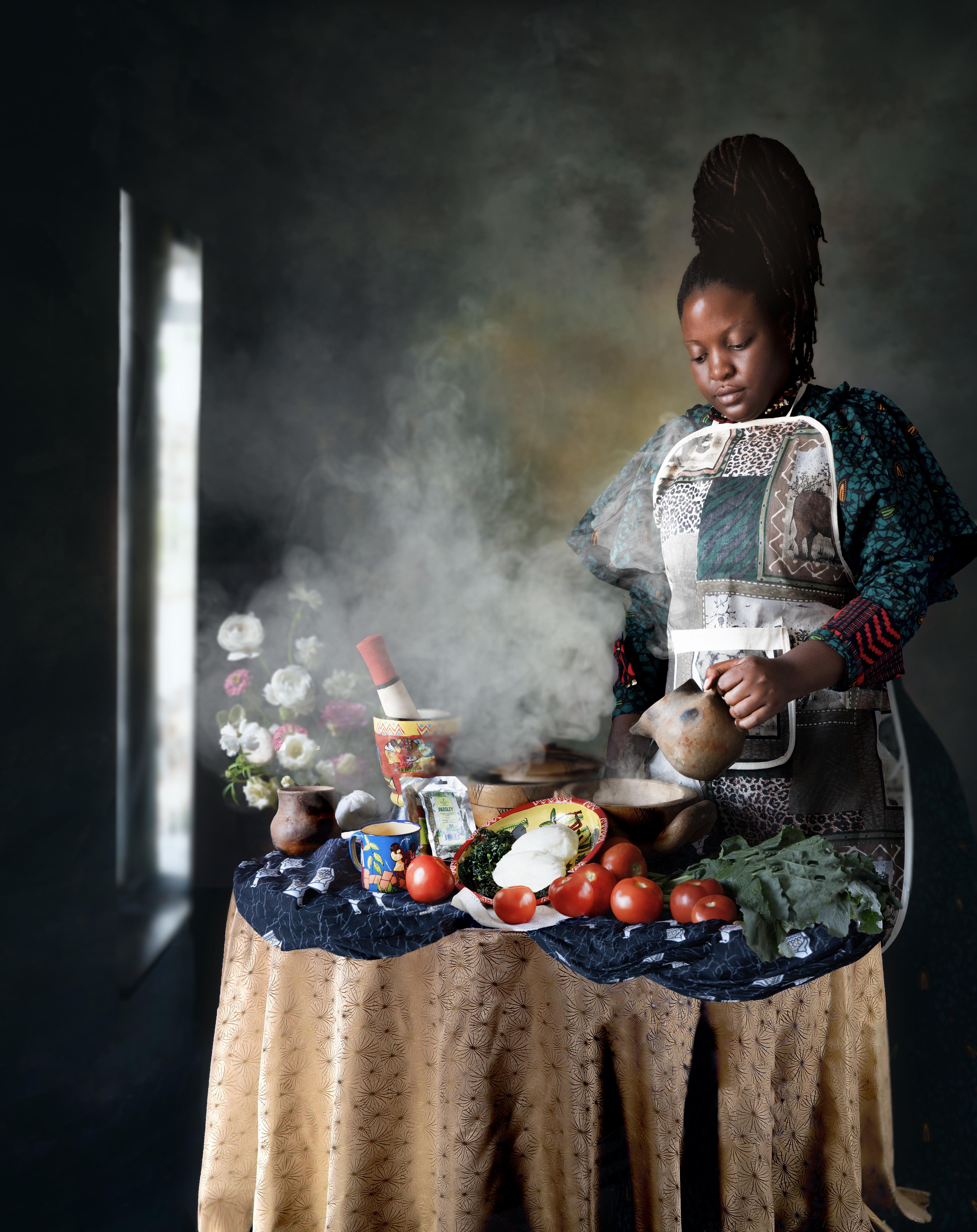
Tamary Kudita (Zimbabwean, b. 1994), Muroora, from the series Birds of Paradise, 2022, inkjet print, Private Collection of Lesley Goldwasser and Jonathan Plutzik, with thanks to VISU Contemporary art gallery, © Tamary Kudita
Description
I’m Charlotte Ogorek, the museum’s Rexroth Project Assistant. I am reading the description for Muroora in Tamary Kudita: African Victorian and Birds of Paradise.
Muroora is a large, vertically oriented photograph that is 48.68 inches tall and 39.16 inches wide. The inkjet print was created in 2022 as a part of the Birds of Paradise series by Tamary Kudita, an artist born in Zimbabwe in 1994.
This image features a dark interior setting, with light entering through an obscured window on the left of the frame. In the foreground, there is a table dressed in a beige tablecloth and a dark blue tablecloth. On the table, there are a variety of cooking items, such as red tomatoes, a dark green, leafy vegetable, spice packets, a mug, and a mortar and pestle. A vase with a bouquet of pink and white flowers sits behind the objects on the left. Behind and to the right of the table stands a Black African woman, with locs up in a bundle high on her head. She wears a teal and black patterned garment beneath an apron consisting of panels of various prints- beige and brown cheetah print, teal and black zebra stripes, and other drawn images of animals in various reds and browns. She is engaged with the objects on the table, and holds an organic looking pitcher in her left hand, pouring something into steaming wooden bowls. Her gaze is fixed on her craft, and she wears a relaxed expression on her face.
Label
I’m Charlotte Ogorek, the museum’s Rexroth Project Assistant. I am reading the label for Muroora in Tamary Kudita: African Victorian and Birds of Paradise.
Muroora is a large, vertically oriented photograph that is 48.68 inches tall and 39.16 inches wide. The inkjet print was created in 2022 as a part of the Birds of Paradise series by Tamary Kudita, an artist born in Zimbabwe in 1994.
Muroora is a reinterpretation of Johannes Vermeer’s painting, The Milkmaid (circa 1658). In Shona culture, muroora (daughter-in-law), is a common sculptural motif. It suggests an idealized femininity centered on humility, youthful beauty, servitude, and fertility—ideas similar to those the milkmaid symbolized in a European context.
But Kudita’s Muroora is a portrait of a real woman. Everyday items on the table, including the spices she sells as a side hustle, represent her self-reliance and passion for cooking as much as her place in a family structure. Here, Vermeer’s painting is a meaningful point of reference because it highlights role of representation in patriarchy across cultures and because it broaches the interior life of a woman placed in a subservient social position.
Hair Tales
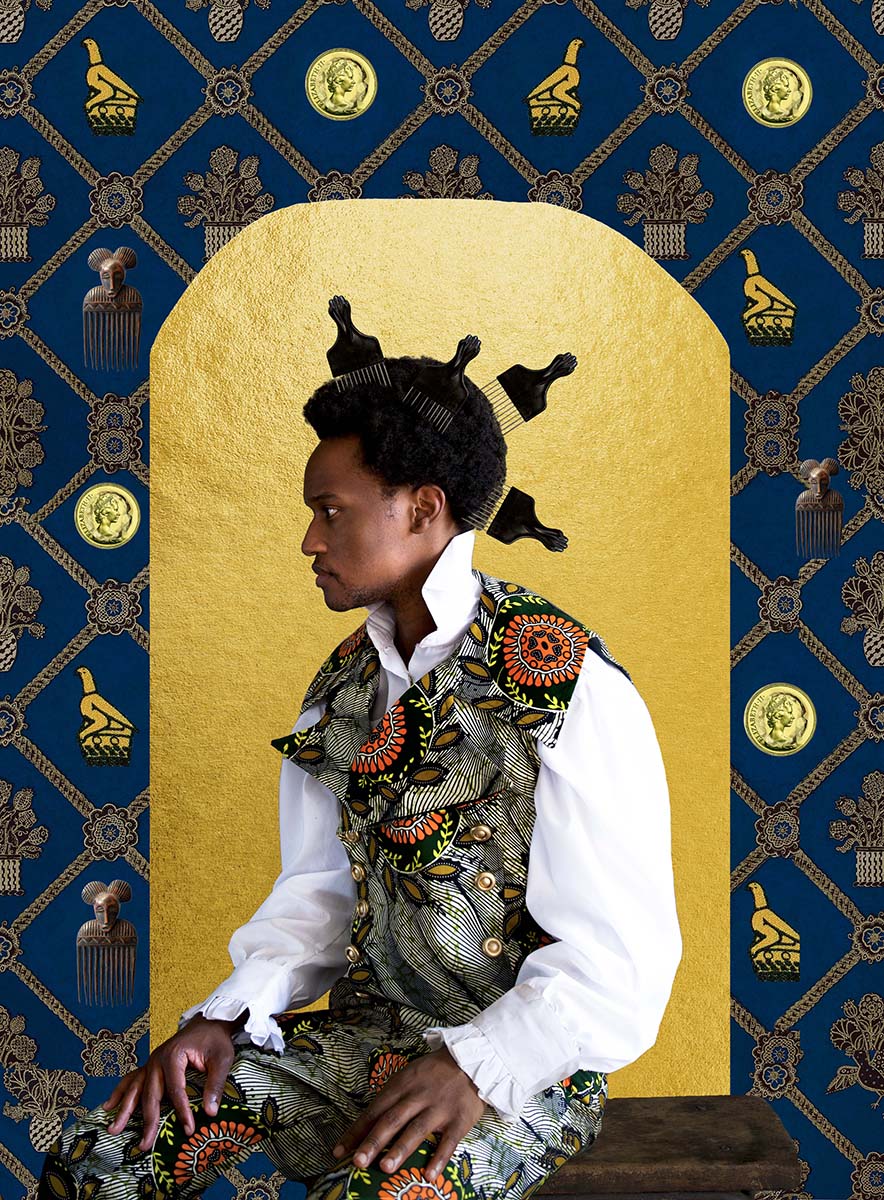
Tamary Kudita (Zimbabwean, b. 1994), Hair Tales, from the series Birds of Paradise, 2022, inkjet print, Private Collection of Lesley Goldwasser and Jonathan Plutzik, with thanks to VISU Contemporary art gallery, © Tamary Kudita
Description
I’m Charlotte Ogorek, the museum’s Rexroth Project Assistant. I am reading the description for Hair Tales in Tamary Kudita: African Victorian and Birds of Paradise.
Hair Tales is a vertically oriented photograph measuring 48.68 inches tall and 36.57 inches wide. The inkjet print was created as a part of the Birds of Paradise series in 2022 by Zimbabwean artist Tamary Kudita, born in 1994.
This work is a portrait of a person in profile seated on a bench and framed by a golden rectangle with rounded corners at the top, against a deep blue wallpaper-like background. The background is decorated with a pattern of rope-like lines and floral motifs which create diamond shapes. Within these diamonds, there are three additional motifs repeated: the coin of Queen Elizabeth II of England, hair picks with decorative handles reminiscent of African masks, and a hieroglyphic-style figure of a birdlike creature.
The sitter is a young Black African man wearing a high-collared white button-up shirt with ruffled cuffs beneath a decorative vest with large gold buttons and mandala-like circles of orange, black, white, green, and gold. His pants are made of the same fabric. He is positioned in three-quarters view, with his body turned towards the left of the frame and his head turned completely in the same direction. His hair is combed out into a short Afro style, with four black picks protruding from it in various directions. He stares straight ahead, out of the frame, and his hands rest on his lap.
Label
I’m Charlotte Ogorek, the museum’s Rexroth Project Assistant. I am reading the label for Hair Tales in Tamary Kudita: African Victorian and Birds of Paradise.
Hair Tales is a vertically oriented photograph measuring 48.68 inches tall and 36.57 inches wide. The inkjet print was created as a part of the Birds of Paradise series in 2022 by Zimbabwean artist Tamary Kudita, born in 1994.
A digitally composited border, patterned with British coins and ancient combs, echoes this model's striking profile set off against a field of gold. Symbolically, Hair Tales suggests that African hair is a proud inheritance and an elevated form of social currency. On a more direct level, the photographer’s personal knowledge of her models allows the picture to work as a portrait of an individual. As Kudita has stated, “he loves his hair—it’s what makes him him. His gaze, the way he commands, can’t be scripted. It comes from our interaction in the moment.”
Thoughts of a Black Man
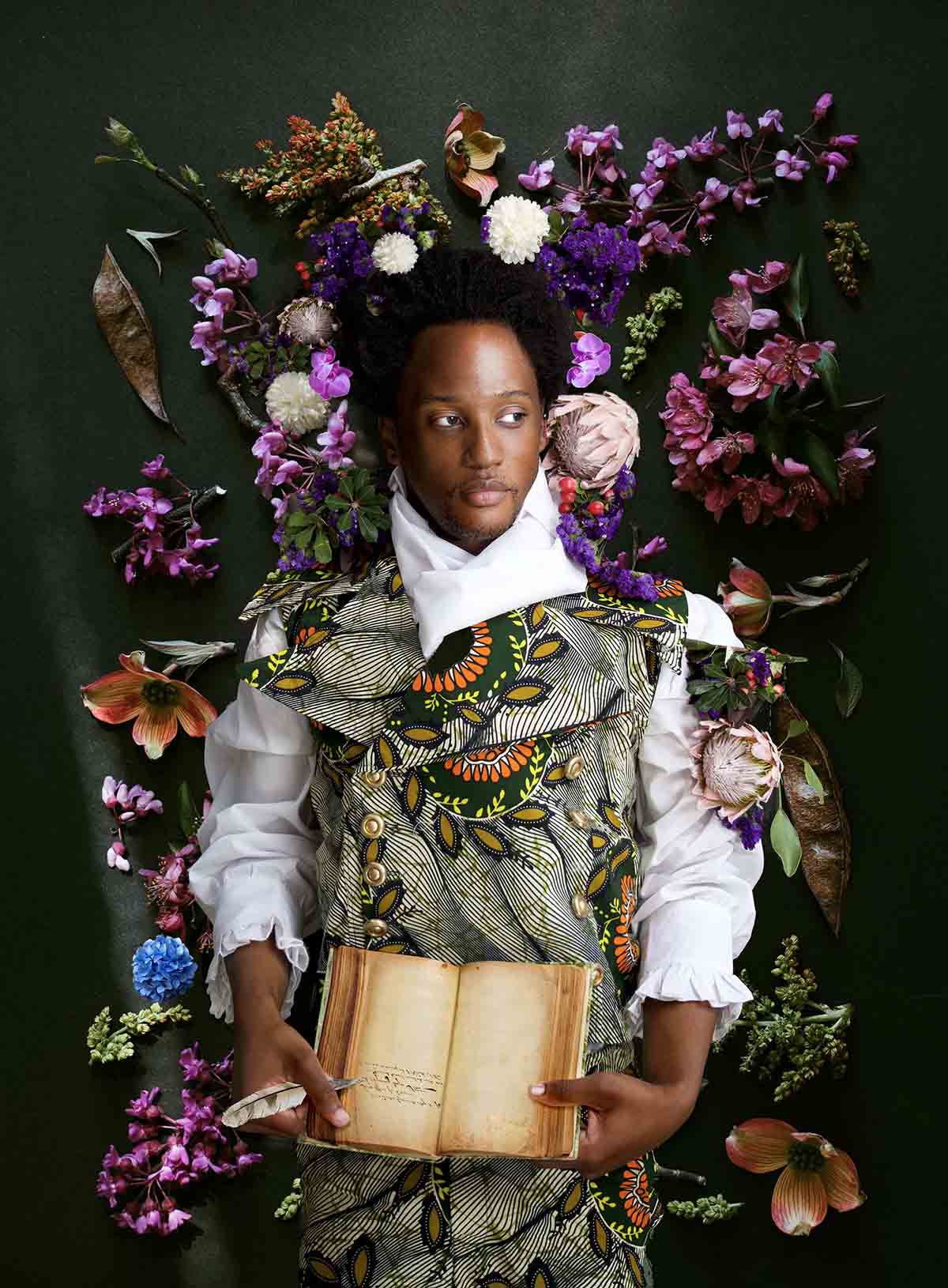
Tamary Kudita (Zimbabwean, b. 1994), Thoughts of a Black Man, from the series Birds of Paradise, 2022, inkjet print, Private Collection of Lesley Goldwasser and Jonathan Plutzik, with thanks to VISU Contemporary art gallery, © Tamary Kudita
Description
I’m Charlotte Ogorek, the museum’s Rexroth Project Assistant. I am reading the description for Thoughts of a Black Man in Tamary Kudita: African Victorian and Birds of Paradise.
Thoughts of a Black Man is a vertically oriented photograph measuring 48.68 inches tall and 36.55 inches wide. The inkjet print was created as a part of the Birds of Paradise series in 2022 by artist Tamary Kudita, born in Zimbabwe in 1994.
This image is a portrait of a young Black African man who appears to be laying on his back against a black, silky looking background. He is surrounded by an array of various flowers, mostly in shades of pink and purple, as well as green leaves and brown seed pods. He wears a high-collared white button-up shirt with ruffled cuffs beneath a decorative vest with large gold buttons and mandala-like circles of orange, black, white, green, and gold. His pants are made of the same fabric. In his hands, he holds a feather quill and an open book with brown, aged paper. The pages visible are blank other than a few lines of cursive writing in black ink, and his expression is pensive as he looks off into the right of the frame from the corner of his eye.
Label
I’m Charlotte Ogorek, the museum’s Rexroth Project Assistant. I am reading the label for Thoughts of a Black Man in Tamary Kudita: African Victorian and Birds of Paradise.
Thoughts of a Black Man is a vertically oriented photograph measuring 48.68 inches tall and 36.55 inches wide. The inkjet print was created as a part of the Birds of Paradise series in 2022 by artist Tamary Kudita, born in Zimbabwe in 1994.
This model also appears in Hair Tales, on view nearby. Here, Kudita invites viewers to reflect on the multifaceted nature of his personality by picturing him not as a public icon, but in a quiet, almost dreamlike moment. Contrary to negative stereotypes of African masculinity, he is thoughtful and feeling, devoted to his family, and a caring force in his community.
Liberty 1980
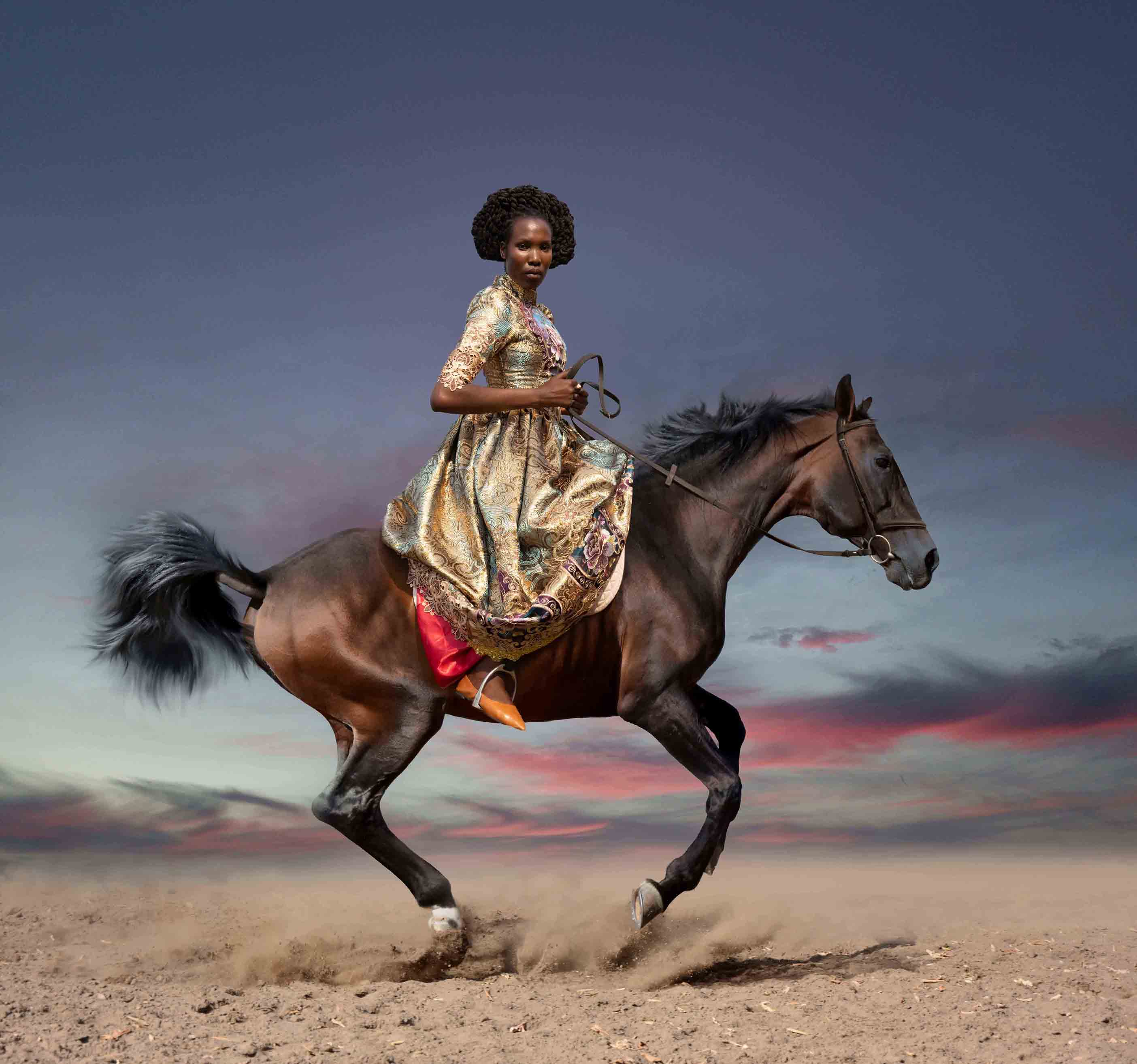
Tamary Kudita (Zimbabwean, b. 1994), Liberty 1980, from the series Birds of Paradise, 2022, inkjet print, Private Collection of Lesley Goldwasser and Jonathan Plutzik, with thanks to VISU Contemporary art gallery, © Tamary Kudita
I’m Charlotte Ogorek, the museum’s Rexroth Project Assistant. I am reading the description for Liberty 1980 in Tamary Kudita: African Victorian and Birds of Paradise.
Liberty 1980 is a large, nearly square format photograph measuring 48.68 and 45.79 inches. This inkjet print was created as part of the series Birds of Paradise in 2022 by the artist Tamary Kudita, born in Zimbabwe in 1994.
This image is set in a barren desert, with no vegetation or foliage, only uneven, light tan sand. It appears to be dawn or dusk, as the sky is a gradient of blue, with deep blue at the top of the image transitioning into light blue as it meets wispy pink clouds on the horizon. In focus and centered in the foreground, a Black African woman sits atop a horse, holding the reins. Both the horse and the woman are captured in side-profile facing the right of the frame, with the horse’s legs bent inwards indicating that it is mid-gallop, and the woman’s head turned to face the camera. Her expression is serious, and she wears her hair in a thick bundle of twists, forming a halo of hair around her head. She is dressed in a gold, brown, soft blue and purple patterned silk dress with a tight bodice, sleeves that stop just before her elbow, and a long skirt, reminiscent of eighteenth-century European attire. Peeking out from beneath her skirt is a hot-pink fabric that rests just above her foot, on which she wears a bright orange, pointed-toe flat. The horse is a deep chestnut brown with a black mane and tail, and wears reigns and a saddle, which is not visible other than the stirrup in which the rider’s foot rests.
I’m Charlotte Ogorek, the museum’s Rexroth Project Assistant. I am reading the label for Liberty 1980 in Tamary Kudita: African Victorian and Birds of Paradise.
Liberty 1980 is a large, nearly square format photograph measuring 48.68 and 45.79 inches. This inkjet print was created as part of the series Birds of Paradise in 2022 by the artist Tamary Kudita, born in Zimbabwe in 1994.
1980 was the year that Zimbabwe became an independent nation, ending nearly a century of British colonial rule. Women fought in the war leading up to independence, but their role goes unrecognized in Zimbabwe’s national stories. There are no monuments to them. Liberty 1980 is Kudita’s answer to that historical erasure. She pictures her model as a commanding mounted rider—a motif familiar from innumerable statues and paintings of Anglo-European male military heroes. Unflappable and gazing directly at the camera, the real person who sits atop the horse wears the shoes of a contemporary heroine: a woman who does it all, in pumps.






